ICSE Class 10 Biology Absorption by Roots Questions and Answers
ICSE SolutionsSelina ICSE Solutions
APlusTopper.com provides ICSE Solutions for Class 10 Biology Chapter 3 Absorption by Roots for ICSE Board Examinations. We provide step by step Solutions for ICSE Biology Class 10 Solutions Pdf. You can download the Class 10 Biology ICSE Textbook Solutions with Free PDF download option.
Download Formulae Handbook For ICSE Class 9 and 10
Short Questions
Question 1: How is root hair structurally adapted for absorption of water from the soil ?
Answer: (i) The root hair represents a large surface area in contact with the soil particle.
(ii) The minute root hair can penetrate between the soil particles and when it comes in contact with soil water, the cell membrane allows efficient entry of water into the root.
(iii) The cytoplasm and the vacuoles also help in this water absorption by osmosis.

Question 2: Root hairs become flaccid, when fertilizers are added to the moist soil around it. Explain.
Answer: When fertilizers are added to the moist soil around it, it will form hypertonic solution, resulting the protoplasm to shrink and plasma membrane withdraw itself from the cell wall. Hence, the root hairs also become limp or flaccid.
Question 3: What do you mean by transpiration pull ?
Answer: Transpiration pull: As the water is lost from the leaf surface by transpiration, more water molecules are pulled up due to the tendency of water molecules to remain joined (cohesion), and thus- to produce a continuous column of water through the stem. This phenomenon is known as transpiration pull.
Question 4: Define the Cohesive and Adhesive forces.
Answer: Cohesive Force: The force produced by the molecular attraction between water particles.
Adhesive Force: The force of attraction between the molecules of unlike bodies that act to hold them together is called adhesive force.
Question 5: Give at least three uses of water to green plants.
Answer: (i) Water is major component of protoplasm.
(ii) It is an important raw material for photosynthesis.
(iii) Most metabolic and enzymatic reactions take place in the presence of water.
Question 6: What is toxicity ?
Answer: It refers to the kind of external osmotic environment of a cell or it refers to the type of solution outside the cell.
Question 7: “Grapes shrink when immersed in a very strong sugar solution.” Explain.
Answer: Very strong sugar solution is hypertonic to the grapes juice. Therefore, water from inside the grapes moves to outside hypertonic solution. It results shrinkage of the grapes.
Question 8: What is the significance of diffusion ?
Answer: Significance of Diffusion:
(i) It helps in the exchange of respiratory gases.
(ii) It helps in the transport of food molecules without the plant body.
Question 9: What is the water potential ?
Answer: Water potential is a measure of potential energy of water or the difference in potential energy between a given water sample and pure water.
Question 10: A few RBC’s were kept in three test tubes containing isotonic, hypotonic and hypertonic solutions. What will be the expected observations after a few hours ? Explain.
Answer: The shape and size of the cells will remain unchanged in isotonic solution, because the cells will neither loose nor gain water in it.
Cells will swell up in hypotonic solution as water will enter in it due to endosmosis.
Cells will shrink in hypertonic solution as water will move out of the cell due to exosmosis.
Question 11: Explain why the grass in your lawn becomes greener if you add a little fertilizer to it, but it dies if you add a lot of it.
Answer: If a little fertilizer is added, it provides minerals and other nutrients so the leaves synthesize more chlorophyll and appear greener. If a lot of fertilizer is added, it forms a hypertonic solution resulting in plasmolysis and consequently wilting of parts of the plant. Ultimately the plant dies.
Give Reasons
Question 1: It is necessary to maintain a normal osmotic concentration of the blood.
Answer: Osmotic pressure is maintained in blood to prevent dehydration leading to shrinkage of cells.
Question 2: Salt and sugar are used in preserving food.
Answer: Salt and sugar increase concentration of food, destroying bacteria by plasmolysis.
Question 3: On sprinkling common salt on grass growing in a lawn, the grass is killed.
Answer: Sprinkling salt makes soil solution hypertonic hence grass lose water due to exosmosis.
Question 4: The raising swell up in water.
Answer: The raisins are dry grapes. When these are kept in water, it enters into the raisins by osmosis (endosmosis) and raisins swell up.
Question 5: We gargle with saline water in case of throat infection.
Answer: The salt solution (saline water) is hypertonic and when we gargle with it, comes in contact of infection causing bacteria in the throat. The water present in the bacterial cell comes out causing plasmolysis and they get killed giving us relief from infection.
Question 6: The leaves of wilted lettuce, if kept in cold water, become crisp.
Answer: The leaves of wilted lettuce are plasmolysed which when kept in the water get deplasmolysed and become turgid. Hence the leaves become crisp.
Question 7: Bacteria and fungi do not grow in pickles, jams, jellies and squashes, etc.
Answer: Pickles, jams, jellies and squashes are kept in hypertonic solution of sugar or salt which causes the plasmolysis of bacteria and fungi. So, they cannot grow in such an unfavourable environment.
Question 8: Fresh water fish cannot survive in sea water.
Answer: The sea water is saline (having more concentration of salts) and acts as hypertonic solution for the fresh water. So fresh water fish cannot survive in sea water as it causes the plasmolysis of the cells of the fish and ultimately the fish will die.
Question 9: A closed can of dried seeds bursts open if some water enters it by accident.
Answer: If some water enters in a closed can of dried seeds, the seeds absorb water by imbibition and osmosis and swell up. The swelling up of seeds exerts a force on the walls of the can, and hence the can bursts open.
Question 10: Drops of water on a leaf of plant like peepal does not enter the leaf by osmosis ?
Answer: Due to the presence of cuticle, which does not allow water molecules to pass through it.
Question 11: Plants growing in fertilized soil are often found to wilt, if the soil is not adequately watered. Why?
Answer: The concentration of water molecules being less outside, endosmosis takes place resulting in the wilting of the plants.
Question 12: Plants begin to die when excess of soluble fertilizers are added to the soil ?
Answer: Excess application of soluble fertilizers in soil makes the soil solution hypertonic than cell sap, hence exosmosis takes place and plants begin to die.
Differentiate
Question 1: Osmosis and Diffusion.
Answer:
| Osmosis | Diffusion |
| Osmosis is a special type of diffusion which involves the movement of solvent molecules from a region of their higher concentration to a region of their lower concentration through a semi-permeable membrane. | Diffusion is the movement of solute molecules or ions from a region of their higher concentration to a region of their lower concentration without the influence of a semi permeable membrane. |
Question 2: Turgid and Flaccid.
Answer:
| Turgid | Flaccid |
| (i) The cell is filled with water so that its cell wall is in a state of tension. | The cell loses water from the vacuole and cytoplasm under plasmolytic condition. |
| (ii) It occurs due to endosmosis. | It occurs due to exosmosis. |
Question 3: Permeable and Semi-permeable membrane.
Answer:
| Permeable Membrane | Semi-permeable Membrane |
| A permeable membrane has pores which allow free movement of solute as well as solvent molecules. | A semi-permeable membrane has pores which allow only solvent molecules to pass through them. |
Question 4: Active transport and Passive transport.
Answer:
| Active Transport | Passive Transport |
| Minerals in solution are transferred from a region of their lower concentration to one of their higher concentration by using metabolic energy. | Minerals are transferred from a region of their higher concentration to a region of their lower concentration without using metabolic energy. |
Question 5: Turgor pressure and Wall pressure.
Answer:
| Turgor Pressure | Wall Pressure |
| It is the pressure applied by the contents of a turgid cell on its cell wall. | It is the pressure exerted by the cell wall on its content. |
Question 6: Turgor pressure and Root pressure.
Answer:
| Turgor Pressure | Root Pressure |
| It is the pressure of the cell. Contents of a turgid cell on its cell wall. | It is the pressure under which water passes from the living cells into the xylem of root. |
| It is caused when a cell becomes turgid. | It is caused due to alternate turgidity and flacidity of root cells. |
Question 7: Plasmolysis and Deplasmolysis.
Answer:
| Plasmolysis | Deplasmolysis |
| In this, the protoplasm of the cell shrinks away from the cell wall. It results in the flaccid condition of the cells and the plant. | In this, the protoplasm of the cell swells up and touches the cell wall. It results in the turgid condition of the cells and the plant. |
| Caused due to exosmosis. | Caused due to endosmosis. |
Question 8: Endosmosis and Exosmosis.
Answer:
| Endosmosis | Exosmosis |
| It occurs when a cell is placed in a hypotonic solution. | It occurs when a cell is placed in a hypertonic solution. |
| Water moves in to the cell. | Water moves out of the cell. |
Diagram Based Questions
Question 1: In the figure below ‘A’ shows a cell in the normal state and ‘B’ shows the same cell after leaving it in a certain solution for a few minutes.

(i) Describe the change which has occurred in the cell as seen in B.
(ii) Give the technical term for the condition of the cell as reached in B and as it was in A.
(iii) Define the process which led to this condition.
(iv) What was the solution-isotonic, hypotonic or hypertonic, in which the cell was kept ?
(v) How can the cell in B, be brought back to its original condition ?
(vi) Name the parts numbered 1 to 3.
Answer: (i) Exosmosis (exit of water) has resulted in the shrinkage of the protoplasm of cell B.
(ii) Plasmolysis and deplasmolysis.
(iii) When plant cells are kept in a hypertonic solution, exosmosis takes place. This process is called plasmolysis.
(iv) Hypertonic solution.
(v) The cell in B can be brought back to its original condition by placing it in a drop of distilled water.
(vi) 1. Cell wall, 2. Plasma membrane, 3. Chloroplast.
Question 2: The alongside diagram A shows a root hair growing through the soil particles. The diagram B is the root hair of an aquatic plant.

(i) Name the parts 1,2,3.
(ii) Name two substances which enter the root hair. What are their uses ?
(iii) By what process do these substances enter the root hair ?
(iv) Account for the different shapes of root hairs in the two diagrams.
Answer: (i) 1-Nucleus. 2-Cell wall. 3-Cytoplasm of the root hair cell.
(ii) 1. Water: Carries minerals to the plant.
2. Minerals : They are needed for healthy plant growth.
(iii) Osmosis.
(iv) In the Fig. A, the root hair has to pass through the soil particles and as such they are not straight. In the Fig. B, the root hair has no obstruction in water, and as such it grows straight.
Question 3: Given below is the diagram of a cell as seen under the microscope after having been placed in a solution :

(i) What is the technical terms used for the state/condition of the cell given above ?
(ii) Give the technical term for the solution in which the cell was placed.
(iii) Name the parts numbered 1 to 4.
(iv) Is the cell given above a plant cell or an animal cell ? Give two reasons in support of your answer as evident from the diagram.
(v) What would you do to bring this cell back to its original condition.
Answer: (i) Plasmolysis
(ii) Hypertonic solution
(iii) (1) Nucleus, (2) Sugar drops, (3) Small vacuole, (4) Large vacuole.
(iv) Plant cell (1) Presence of cell wall, (2) Presence of large vacuole.
(v) It has to be placed in a hypotonic solution.
Question 4: The below diagram represents a plant cell after being placed in a strong sugar solution. Guidelines 1 to 5 indicate the following :
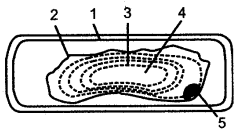
1. Cell wall
2. Plasma membrane.
3. Protoplasm
4. Large vacuole
5. Nucleus
Study the diagram and answer the questions that follow :
(i) What is the state of the cell shown in the diagram ?
(ii) Name the structure which acts as a selectively permeable membrane.
(iii) If the cell had been placed in distilled water instead of strong sugar solution which feature : would not have been present ?
(iv) If the cell in the diagram possessed chloroplasts where would these be present ?
(v) Name any one feature of this plant cell which is not present in animal cells.
Answer: (i) Flaccid.
(ii) Plasma membrane.
(iii) If the cell had been placed in distilled water it remains in a fully distended condition. Its plasma membrane remains in close contact with the cell wall and presses against it.
(iv) Chloroplast will be present in the protoplasm outside the vacuole.
(v) Cell wall.
Question 5: The figure given below is a diagrammatic representation of a part of the cross-section of the root in the root hair zone. Study the same and then answer the questions that follow :

(i) Name the parts indicated by guidelines ‘1’ to ‘5’
(ii) Is the root hair cell unicellular or multi-cellular ?
(iii) Draw a labeled diagram of the root hair cell as it would appear if some fertilizer is added to the soil close to it.
(iv) Name the process responsible for the entry of water molecules from the soil into A1 and then A2.
(v) What pressure is responsible for the movement of water in the direction indicated by arrows ?
(vi) How is this pressure set up ?
Answer: (i) 1. Vacuole (containing cell sap)
2. Soil particles
3. Xylem vessel
4. Cortex cells
5. Vacuole in cortical cells
(ii) Root hair cell is unicellular
(iii) See diagram alongside.
(iv) Osmosis
(v) Osmotic pressure
(vi) This pressure is set up due to difference in osmotic gradient.
Question 6: The below figure shows a root hair:
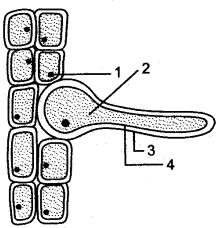
(i) Label the parts 1 to 4.
(ii) What is the role of part 4 ?
(iii) Why is the root hair one-celled ?
(iv) What will happen to the root hair if some fertilizer is added to the soil near the root hair ?
Answer: (i) 1. Nucleus
2. Vacuole
3. Cell wall
4. Cell membrane
(ii) Part 4 is the cell membrane. It is semi-permeable. It allows only water molecules to pass through it.
(iii) Because it is an extension of epiblema cell.
(iv) By the addition of fertilizer, root hair becomes flaccid, because water will move out of it as soil water becomes hypertonic.
Question 7: The diagram given below is of an experiment just at the start. Study the diagram carefully and answer the following questions :

(i) What does the experiment demonstrate ?
(ii) Define, the process demonstrated in the experiment.
(iii) What changes are observed after a few hours?
(iv) Give two examples of a semi permeable membrane.
(v) Which limb of the U-tube contains more concentrated sucrose solution,, A or B?
(vi) Why is the membrane separating the two solutions labeled as semi permeable membrane?
Answer: (i) The process of osmosis.
(ii) Osmosis is a special type of diffusion of solvent molecules through a semi-permeable membrane from region of their higher concentration to the lower concentration region, but not vicevers.
(iii) The level of water in column A will rise along with passage of time and will ultimately stop when concentration of water molecules are equal on both sides of the membrane.
(iv) (a) Parchment paper, (b) Egg membrane.
(v) Solution A.
(vi) It permits the movement of only water molecules to pass through it.
Question 8: A plant cell kept in a drop of water was examined under the low power magnification of a microscope, as shown:

(i) What would you do to bring this cell back to its original condition?
(ii) What scientific terM is used for such condition?
(iii) Draw the same cell if it is kept in a strong sugar solution.
Answer: (i) Put the cell back into drop of water for sometime. Deplasmolysis occurs.
(ii) Plasmolysis.
(iii) Plasmolysed cell.

Question 9: The apparatus arranged here signifies an important process.
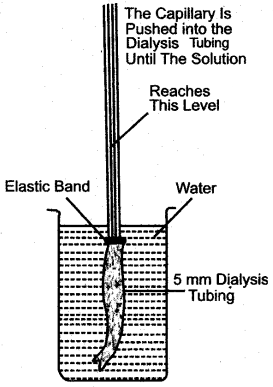
(i) Name the process.
(ii) Where does this process occur in plants?
(iii) What solution is placed inside the dialysis tubing?
(iv) What happens to the level of the solution in the capillary tube ?
(v) Define the process mentioned in Q. (i) above.
Answer: (1) The process is called osmosis.
(ii) This process occurs in the root hair cells of plants.
(iii) The solution placed inside the dialysis tubing is generally strong sugar solution or salt solution.
(iv) The level of the solution in the capillary tube rises above the original level.
(v) Osmosis is a physiological process where the water molecules or solvent molecules move through a semi permeable membrane from a solution having a higher concentration of solvent molecules to the solution having a lower concentration of water or solvent molecules.
Question 10: Given below is the figure of an experimental set up to demonstrate root pressure.

(i) Define root pressure.
(ii) What change would you observe in the water level after sometime?
(iii) What role is being played by the root pressure in the given experiment?
(iv) Why the oil has been sprinkled on water?
Answer: (i) The collective force exerted by the cortical cells of the root in forcing water upward into the xylem is known as root pressure.
(ii) The water level will rise in the glass tube.
(iii) Root pressure is forcing the water up in the stem.
(iv) To prevent evaporation of water from the tube.
Question 11: The diagram given below represents the result of an experiment conducted on two freshly taken shoots of a green herbaceous plant. The lower ends dip in water.
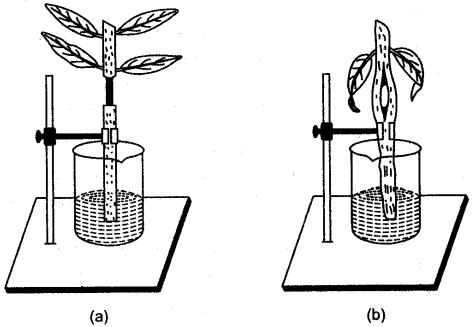
(i) What is the aim of the experiment?
(ii) Some parts of the stem in both the shoots have been removed. Name the conducting tissue in shoot A and in shoot B, that have been removed. ‘
(iii) What are the results of this experiment?
Answer: (i) To demonstrate the role of xylem and phloem in flowering plants.
(ii) In shoot A phloem tissue has been removed. In shoot B central xylem tissue has been removed.
(iii) Plant A gets water and minerals and synthesizes its food and remains healthy. Plant B due to lack of xylem does not get its supply of water and minerals. The leaves are seen drooping and will dry.
Question 12: A thin strip of epidermal cells from the fleshy scales of an onion bulb was examined in a drop of water, under a microscope. All the epidermal cells looked alike and the figure alongside represents one of them. The thin strip was then transferred to a drop of strong sugar solution and re-examined under the microscope after about five minutes.

(i) Make a sketch of one of the epidermal cells, as it might appear after immersion in strong sugar solution. Label any two parts which has undergone a change.
(ii) Give the scientific term for the change shown in Q.(i) above.
(iii) What would you do to bring this cell back to its original condition?
(iv) Give the scientific term used for the recovery of the cell as a result of the step taken in Q.(iii) above.
Answer: (i) See figure.
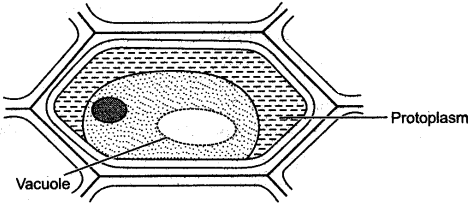
(ii) Plasmolysis.
(iii) We would immerse this cell into fresh water, i.e., hypotonic solution.
(iv) Deplasmolysis.
Question 13: Given below is an experiment demonstration.

(i) Which phenomenon has been demonstrated in the given figure.
(ii) What is solute and what is solvent in the above experiment.
(iii) Define the phenomenon in Q. (i) above.
(iv) Give one example from your daily life experiences based on this principle.
Answer: (i) Diffusion.
(ii) KMnO4 crystals represent the solute and water is solvent.
(iii) The movement of the molecules of a substance from the re.gion of their higher concentration to the region of their lower concentration until a state of equilibrium is achieved in both the regions.
(iv) If a bottle of scent or spirit is opened in one comer of a closed room, its smell can be felt in every part of the room.
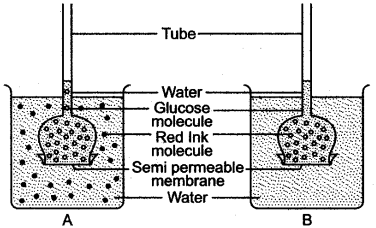
Question 14: In an experiment, two sets of apparatus were set up as shown below:
In A there is concentrated sugar solution inside the thistle funnel and red ink in the water outside the funnel. In B there is concentrated glucose solution with red ink inside the thistle funnel and water outside the thistle funnel.
In both A and B the level of liquid inside the funnels rises up the tubes. In A the sugar solution turns red and in B, the water turns red.
Study the given observations and answer these questions:
(i) Name the process by which red ink moves in A and B.
(ii) Which type of pressure force the water molecules to move towards thistle funnels and cause rise in the water level?
(iii) Where does this process occur in plants and animals?
(iv) What material could be used as semi-permeable membrane?
Answer: (i) Osmosis.
(ii) Osmotic pressure.
(iii) In plants, in the root cells and in animals in the RBC’s.
(iv) Cellophane paper or goat bladder, etc.
Question 15: The beaker is divided into two chambers A and B. The big circle represents solute and the small circles solvent.
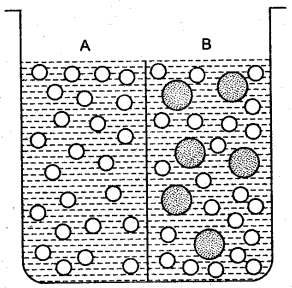
(i) What can you say about the size of the holes in the membrane, if it is to behave semi- permeably between these two ?
(ii) Will the solvent molecules pass through the membrane from left to right, from right to left, in either direction, or in both directions ?
(iii) In which direction will there be a net movement of solvent molecules ?
Answer: (i) The size of the holes in the membrane is large enough to allow only the solvent particles to pass through it. But solute particle cannot pass through it. Thus, the membrane acts as the semi-permeable.
(ii) Solvent molecules will pass through the membrane in both directions. Since solvent molecules are present on both the sides they will strike the semi-permeable membrane and pass through the same.
(iii) There is a net movement of solvent molecules from the place of its higher chemical potential to the place of its lower chemical potential, i.e., from right to left.
Question 16: A complete ring of bark was removed from a tree in spring. The tree continued to live through summer but a swelling appeared on the bark above the ring while the bark below shriveled up. Answer the questions given below :
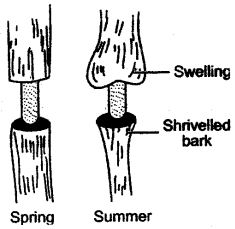
(i) Account for the swelling in the bark above the ring.
(ii) Account for the shrinking of the bark below the ring.
(iii) Name the tissue that distributes food in plants.
(iv) Name the tissue that distributes water in plants.
(v) What is the role of a bark in a plant ?
Answer: (i) The phloem has been removed in the part of the ring. The food prepared by leaves comes down through phloem, but since the phloem is cut off, the food gets collected in the upper part of the ring and hence the swelling appears.
(ii) The food prepared by leaves is not able to pass on downward as the phloem has been removed, resulted in the shrinking of the bark. ‘
(iii) Phloem.
(iv) Xylem.
(v) Bark protects the attack of fungi and insects, against loss of water by evaporation and against variation of external temperature and loss of water due to evaporation.
Question 17: The diagram below represents an experimental set up to demonstrate a vital process. Study the same and then answer the questions that follow:

(i) Name the process.
(ii) Define the above named process.
(iii) What would you observe in the experimental setup after an hour or so ?
(iv) What control experiment can be set up for the above experiment ?
(v) Keepmg in mind the root hair cell and its surrounding name the part that corresponds to (1) Concentrated sugar solution, (2) Parchment paper, (3) Water in the beaker.
(vi) Name any other substance that can be used instead of parchment paper in the above experiment.
(vii) Mention two advantages of this process to the plant.
Answer: (i) Osmosis.
(ii) Transfer of water or solvent molecules from a solution of lower concentration to a solution of higher concentration through a semi-permeable membrane is called osmosis.
(iii) Level of sugar solution rises in the stem of thistle funnel, whereas water level in the beaker falls.
(iv) A non-permeable membrane can be used in place of parchment paper for a control experiment.
(v) (1) Root hair cell sap corresponds to concentrated sugar solution.
(2) Cell membrane of root hair cell corresponds to parchment paper.
(3) Soil solution corresponds to water in the beaker.
(vi) Goat’s bladder or pig’s bladder.
(vii) (1) Helps in water absorption.
(2) Helps in stomatal opening and closing thus facilitating gaseous exchange.
Question 18: A candidate in order to study the process of osmosis has taken 3 potato cubes and put them in 3 different beakers containing 3 different solutions. After 24 hours, in the first beaker the potato cube increased in size, in the second beaker the potato cube decreased in size and in the third beaker there was no change in the size of the potato cube. The following diagram shows the result of the same experiment:

(i) Give the technical terms of the solutions used in beakers, 1,2 and 3.
(ii) In beaker 3 the size of the potato cube remains the same. Explain the reason in brief.
(iii) Write the specific feature of the cell sap of root hairs which helps in absorption of water.
(iv) What is osmosis ?
(v) How does a cell wall and a cell membrane differ in their permeability ?
Answer: (i) Beaker 1: Hypotonic solution
Beaker 2: Hypertonic solution
Beaker 3: Isotonic solution
(ii) In beaker 3 the size of potato cube remains the same because of isotonic solution which has same concentration of solutes as that of potato cells. So water is neither lost hor gained by the potato cells.
(iii) Cell sap of root hairs is much more concentrated than the soil solution and this causes entry of water into the root cells.
(iv) Osmosis is the movement of water molecules from a more dilute solution to a less dilute solution, through a semi permeable membrane.
(v) Cell wall is freely permeable while cell membrane is selectively permeable.
Sketch and Label the Diagram
Question 1: Give a diagrammatic representation of plasmolysis in a cell.
Answer:
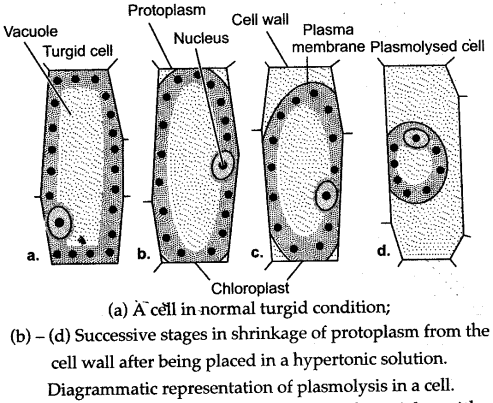
Question 2: Draw a cross-section of root showing association of soil particles with root hairs.
Answer:
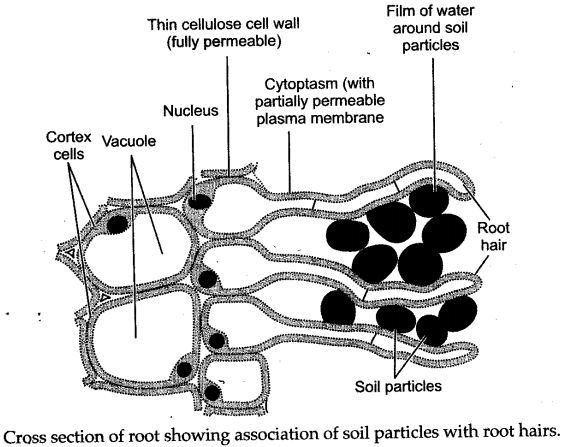
Question 3: Draw a diagram of the root hair cell as it would appear when a concentrated solution of fertilizers is added near it.
Answer:

Question 4: A thin strip of epidermal cells of a leaf was observed in a drop of water. They all looked turgid and normal.
(a) Draw a diagram of such a cell.
(b) Draw a diagram of a cell if this strip is transferred to a strong concentrated solution of sugar. What is term used for the effect on the cells ?
Answer:

Explain the Terms
Question:
1. Diffusion
2. Osmosis
3. Endosmosis
4. Exosmosis
5. Plasmolysis
6. Guttation
Answer: 1. Diffusion: It is the movement of molecules of solid, liquid or gas from their higher concentration area to their lower concentration area.
2. Osmosis: Osmosis is a special type of diffusion which involves the movement of solvent molecules from a region of their higher concentration to their lower concentration.
3. Endosmosis: It is the movement of water molecules from the surroundings into the cell.
4. Exosmosis: It is the movement of water molecules from the cell into the outer surroundings.
5. Flasmolysis: It is the shrinkage of protoplasm from cell wall when a cell is placed in a hypertonic solution.
6. Guttation: The exudation of water in the form of droplets along with sugars and mineral salts, through specialized openings, i.e., hydathodes present along margins of leaf is called guttation.
Name the Following
Question:
1. Water is absorbed from the soil by which part.
2. The kind of cells that constitute the cortex of a root.
3. The pressure through which water can rise upto some feet.
4. Root hairs are the extension of which cells.
5. The movement of a liquid through a selectively permeable membrane.
6. Name the process by which water enters the root hair cell.
7. The process by which raisins swell up when placed in a beaker of water.
8. The membrane which allow water molecules to pass through, but not sugar molecules.
9. The inward movement of solvent molecules through the plasma membrane of a cell.
10. The solution outside the cell having lower solute concentration than the fluids.
11. The process by which wilting or drooping of leaves occurs.
12. The condition in which the contents of a cell exert pressure against the cell wall making it distended.
13. Condition of cell in which the cell content are shrunken.
14. Movement of ions from the region of lower concentration to higher concentration by using energy (ATP).
15. Name the process by which intact plants lose water in the form of droplets.
Answer:
1. Root hairs
2. Parenchyma
3. Root pressure
4. Epidermal cell
5. Osmosis
6. Osmosis
7. Osmosis
8. Selectively or differentially permeable
9. Endosmosis
10. Hypotonic
11. Turgidity
12. Turgidity
13. Plasmolysed
14. Active transport
15. Guttation
Give Technical Terms
Question:
1. Phenomenon of absorption of water by surface attraction.
2. Solutions which have the same osmotic pressure.
3. A solution whose concentration is equal to the cell sap.
4. A solution whose concentration is greater than that of the cell sap.
5. The pressure which is responsible for the movement of water molecules across the cortical cells of the root.
6. The condition in which the water from a cell is completely removed due to exosmosis and no more shrinkage is possible.
7. A cell in a fully extended condition.
8. The pressure exerted by cell contents on a plant cell wall.
9. Condition of a cell placed in a hypotonic solution.
10. Tissue which transports manufactured food from leaves to other parts of the plant.
11. The tissue responsible for the ascent of sap in plants.
Answer:
1. Imbibition
2. Isotonic
3. Isotonic solution
4. Hypertonic
5. Osmotic pressure
6. Plasmolysis
7. Turgid
8. Turgor pressure
9. Turgid
10. Phloem
11. Xylem
12. Xylem
Fill in the Blanks
Complete the following sentences with appropriate words :
1. The pressure which develops in the cortical cells of root which force a part of the water upward Root pressure.
2. Leaves get wilted if Xylem is removed from the plant.
3. Water serves as a medium for the transport of inorganic salts and food molecules in the plant.
4. When there is no movement of water in the cell from the outside medium, the medium is considered to be Isotonic to cell sap.
5. A plasmolysed cell has Shrunken protoplast.
6. Raisin swells up when kept in a Hypotonic solution.
7. Water and mineral salts absorbed by root is known as Sap.
8. The condition opposite to turgid is Flaccid.
9. Diffusion is the movement of molecules from a region of their higher concentration to the region of their lower concentration.
10. Osmosis in the diffusion of Water molecules from the region of higher water-water potential to that of lower potential across a S.P.M.
11. Wilting and drooping of leaves is due to loss of Turgidity.
True & False
Mention, if the following statements are True or False. If false rewrite the wrong statement in its correct form:
1. Xylem is the water conducting tissue in plants. (True)
2. Osmosis is defined as the movement of water from a concentrated sugar solution to a dilute sugar solution. (False, Osmosis is defined as the movement of water from a dilute sugar solution to a concentrated sugar solution.)
3. The plasma membrane permits the passage of all solutes and water. (False, It permits the passage of certain substances.)
4. During exosmosis water moves from inside the cell to the outside of the cell. (True)
5. Plasmolysis makes the cell turgid. (False, It makes the cell flaccid)
6. Cells that have lost their water content are said to be deplasmolysed. (False, The cells that have lost their water content are said to be plasmolysed.)
7. Fladdity is the reverse of turgidity. (True)
Multiple Choice Questions
1. In the process of osmosis in a cell:
(a) Both protoplasm and cell wall act as a membrane
(b) Only cell wall acts as a membrane
(c) Only outermost layer of protoplast acts as a membrane
(d) The entire protoplast acts as a membrane
2. Osmosis involves:
(a) Cell to cell movement of water
(b) Movement of water through cortical cells
(c) Adiva absorption of water through roots
(d) All of the above
3. Plasma membrane controls:
(a) Passage of water only
(b) Passage of water and solutes in and out of the cell
(c) Passage of water and solutes into the cell
(d) Movement of cell contents out of the cell
4. The space between the cell wall and plasma membrane in a plasmolysed cell is filled with:
(a) Isotonic solution (b) Hypotonic solution
(c) Hypertonic solution (d) Water
5. Seeds when soaked in water imbibe in it because:
(a) Osmotic pressure inside the seed is low
(b) Seed coat contains lot of salts
(c) The process of absorption works
(d) There are many vacuoles in the endosperrn
6. Process of endosmosis stops:
(a) When equal
(b) When solution becomes isotonic
(c) When the leaves fall .
(d) When there is no light
7. Marine fish when thrown under tap water bursts because of:
(a) Endosmosis (b) Diffusion
(c) Exosmosis (d) Plasmolysis
8. Osmosis involves diffusion of:
(a) Suspended particles from lower to higher concentration.
(b) Suspended particles from higher to lower concentration.
(c) Molecules or ions from the more concentrated solution to the less concentrated solution.
(d) Water from the less concentrated solution to the more concentrated solution.
9. Water will be absorbed by the root hairs when:
(a) Concentration of solutes in the cell sap is high
(b) Concentration of solutes in the soil is high
(c) The plant is rapidly respiring
(d) None of the above
10. When a plant wilts, the sequence of events will be as follows:
(a) Exosmosis, plasmolysis, deplasmolysis, temporary wilting
(b) Exosmosis, deplasmolysis, plasmolysis, temporary and permanent wilting
(c) Exosmosis, plasmolysis, temporaty and permanent wilting
(d) None of the above
11. When cell is fully turgid, which of the following will be zero?
(a) Osmotic pressure
(b) Turgor pressure
(c) Wall pressure
(d) Suction pressure (SP) or diffusion pressure deficit (DPD)
Match the Column
Column ‘II’ is a list of items related to ideas in Column ‘I’. Match the term in Column ‘II’ with the suitable idea given in Column ‘I’.
| Column I | Column II |
| (i) Diffusion | (a) The exit or flow of water from the cell to the outer environment. |
| (ii) Xylem | (b) The shrinkage of protoplasm when the cell is kept in a hypertonic solution. |
| (iii) Root pressure | (c) The tissue through which water and mineral salts move upward in a plant. |
| (iv) Isotonic solution | (d) Two solutions which have equal osmotic pressure. |
| (v) Exosmosis | (e) The process by which the molecules of perfume spread in the room when the bottle is open. |
| (vi) Osmosis | (f) The process by which roots absorb water from the soil. |
| (vii) Plasmolysis | (g) The pressure by which water rises upto some feet in a lofty tree. |
| (viii) Hypotonic solution | (h) The concentration of the solution when lower than that of the cell sap. |
Answer: (i) (e) (ii) (c) (iii) (g) (iv) (d) (v) (a) (vi) (f) (vii) (b) (viii) (h).
ICSE Solutions for Class 10 Biology
- Cell Division Class 10 ICSE Questions and Answers
- Fundamentals of Genetics Class 10 ICSE Questions and Answers
- Absorption by Roots Class 10 ICSE Questions and Answers
- Transpiration Class 10 ICSE Questions and Answers
- Photosynthesis Class 10 ICSE Questions and Answers
- The Circulatory System Class 10 ICSE Questions and Answers
- The Excretory System Class 10 ICSE Questions and Answers
- The Nervous System and Sense Organs Class 10 ICSE Questions and Answers
- The Endocrine System Class 10 ICSE Questions and Answers
- The Reproductive System Class 10 ICSE Questions and Answers
- Human Population Class 10 ICSE Questions and Answers
- Physical Health and Hygiene Class 10 ICSE Questions and Answers
- Pollution Class 10 ICSE Questions and Answers
